Historic Centre of Riga: Riga is the capital city of Latvia. Riga was founded in 1201 by Albert of Riga. Riga is situated on the Gulf of Riga, at the mouth of the Daugava, the largest river of Latvia. Riga became a member of the Hanseatic League in 1282. Riga was a wealthy Hanseatic City and an important harbour town, the harbour was already used by the Vikings. Latvia was occupied several times by Germany and Russia and was also ruled by Sweden in the 17th century. Many monuments from the past have been preserved in the historic centre of Riga, among them the Mentzendorff House, the Russian Orthodox Cathedral, the Jewish Synagogue, the Swedish Gate and the 15th century House of the Three Brothers. The House of the Three Brothers and the House of the Black Heads are the oldest houses in Riga. The House of the Black Heads is a fine example of Baltic Brick Gothic Style. The 15th century St. Peter's Church has become a cultural and art centre, the spire is the tallest church tower in Riga, an elevator takes visitors up to the observation deck for a spectacular view over Riga. Riga Castle is the official residence of the president of Latvia. The Swedish Gate and the Powder Tower once were part of the defensive city walls of Riga. The Freedom Monument Milda is a national shrine, honouring soldiers who were killed in the Latvian War of Independence from 1918 to 1920. The Central Market of Riga is housed in five giant zeppelin hangars. The Baltic Way was a human chain linking the three Baltic States, Estonia, Latvia and Lithuania, in their drive for freedom. The Baltic Way was a more than 600 km long human chain from Tallinn to Vilnius, crossing Riga. The Baltic Way was inscribed on the UNESCO Memory of the World Register. The Historic Centre of Riga gained the status of a UNESCO World Heritage in 1997.
www.werelderfgoedfotos.nl © Copyright World Heritage Photos
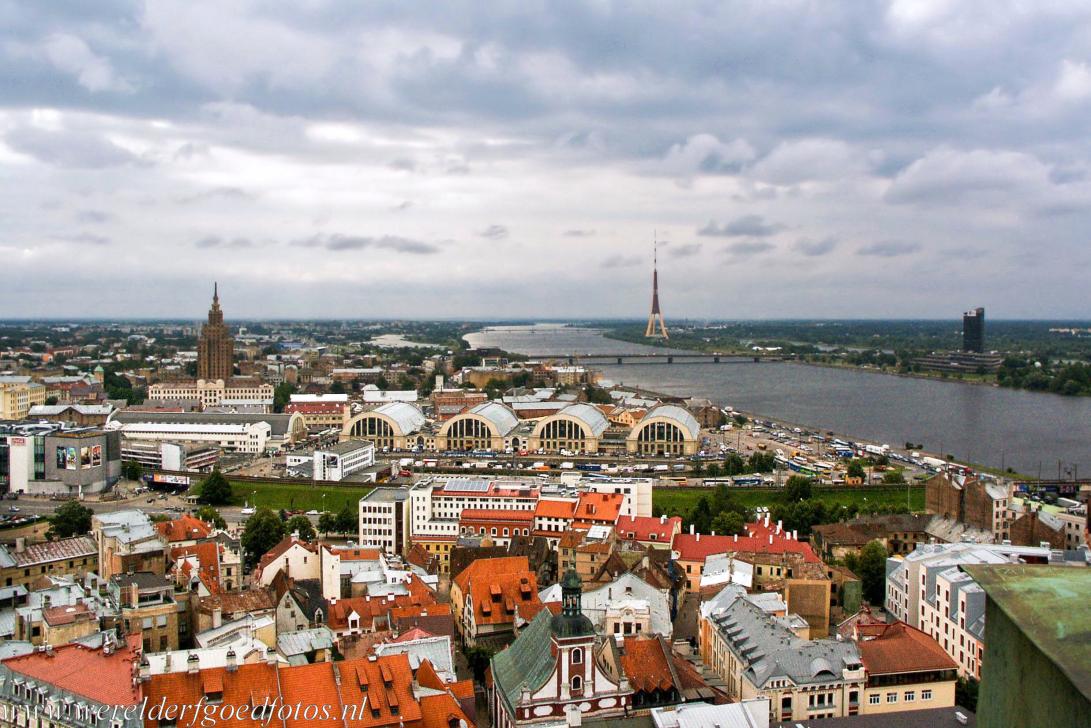
A spectacular view of the historic centre of Riga and the Daugava River from the tower of the St. Peter's Church. Its spire is the tallest church tower in Riga. A modern elevator takes visitors up to the observation deck for an amazing view over Riga, the mouth of the Daugava River and the Riga Central Market, five former German zeppelin hangars. The Historic Centre of Riga gained the status as a UNESCO World Heritage in 1997.

A spectacular view of the historic centre of Riga and the Daugava River from the tower of the St. Peter's Church. Its spire is the tallest church tower in Riga. A modern elevator takes visitors up to the observation deck for an amazing view over Riga, the mouth of the Daugava River and the Riga Central Market, five former German zeppelin hangars. The Historic Centre of Riga gained the status as a UNESCO World Heritage in 1997.
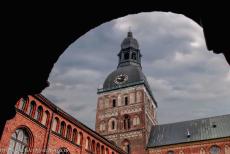
Historic Centre of Riga: The tower of Riga Cathedral viewed from the cloister. The rooster on top of the spire is a symbol of Riga and serves also as a weathervane. Riga Cathedral was built in the period 1211-1300, the cathedral is the largest medieval church in the Baltic States and also one of the oldest religious medieval buildings in Latvia. Riga Cathedral was modified several times. During the Soviet period, the cathedral was a concert hall.
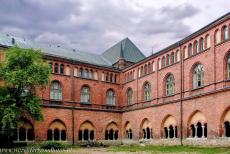
Historic Centre of Riga: The cloister of Riga Cathedral was built in the 13th century. The cloister is a masterpiece of the Early Gothic architecture. Once, the cloister connected the cathedral to the monastery. Riga cathedral was built in different architectural styles such as Romanesque, Early Gothic, Baroque and Art Nouveau. From 1981 to 1984, a Dutch organ building company carried out a major organ reconstruction.
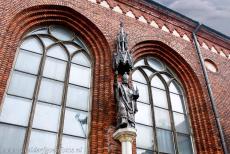
Historic Centre of Riga: The sculpture of Albert of Riga on the façade of Riga Cathedral. Albert of Riga, also known as Albert of Livonia, was the founder of both Riga and Riga Cathedral. Albert of Riga was the third Bishop of Riga. Together with the Hanze merchants of the Baltic Sea Island of Gotland, he founded the city of Riga in 1201 and he laid first stone of Riga Cathedral in 1211, the cathedral was built close to the Daugava River.
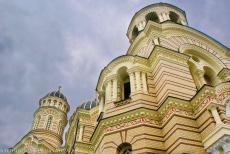
Historic Centre of Riga: The Russian Orthodox Cathedral of Riga, the Nativity of Christ Cathedral. The cathedral was built in the Neo-Byzantine style between 1876 and 1883. The cathedral was built during the period when Latvia was part of the Russian Empire. The onion-shaped dome is the most characteristic feature of the Russian church architecture. The onion-shape is similar to a candle flame and symbolizes the flame of faith reaching up to heaven.
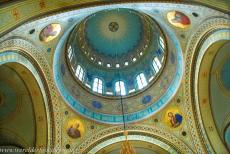
Historic Centre of Riga: The breathtaking interior of the Russian Orthodox Cathedral of Riga. The Russian Orthodox Cathedral also houses numerous Russian icons. During the Soviet period, the cathedral was closed, the church bells were melted down, the crucifixes were removed and the cathedral was converted into a planetarium and restaurant. The Russian Orthodox Cathedral of Riga, or Nativity of Christ Cathedral, was restored in the late 1990s.
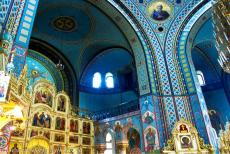
Historic Centre of Riga: The Russian Orthodox Cathedral, also known as the Nativity Cathedral, is renowned for its numerous icons in gilded icon cases, three iconostases, Orthodox ornaments and frescoes. The cathedral is lighted by traditional tall Orthodox church candles. Several icons were made by Vasily Vasilyevich Vereshchagin, a famous Russian artist. The original twelve bells of the cathedral were cast in Moscow and were a gift of the Rudssian Tsar Alexander II.
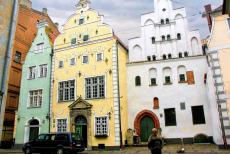
Historic Centre of Riga: The Three Brothers are the oldest stone residential buildings in Riga, the Three Brothers were built at the end of the 15th century when Riga established excellent trade relations with merchants from the Netherlands. The Dutch architecture started to influence the architecture in Riga. The Historic Centre of Riga was inscribed on the UNESCO World Heritage List in 1997.
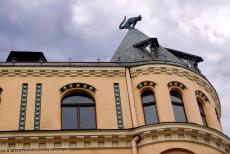
Historic Centre of Riga: The Cat House is embellished with two statues of black cats on its roof. The Cat House was built in 1909. The legend goes that the owner of the Cat House was denied membership to the Great Guild, he was seeking revenge and placed two angry cats on his roof, their tails towards the Great Guild Hall, a symbol of bad luck. When he finally became a member of the guild, the cats were turned around facing the Great Guild Hall.
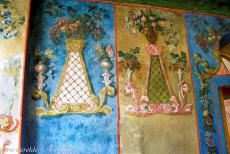
Historic Centre of Riga: The Mentzendorff House is decorated with 18th century wall paintings. The house belonged to a wealthy merchant, he sold the best coffee in the city. The house is a traditional family home of a wealthy household in Riga in the 17th and 18th centuries. Now, the Mentzendorff House is a museum and houses a permanent exhibition of modern glass art and many objects of the merchant family of the Mentzendorffs.
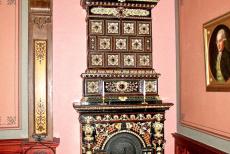
Historic Centre of Riga: The interior of the House of the Brotherhood of Blackheads, the original House of the Blackheads was built in 1334, the building was destroyed during the Second World War, the remains were demolished in 1948. The present-day house was reconstructed between 1995 and 1999. The Brotherhood of Blackheads was a guild for unmarried German merchants.
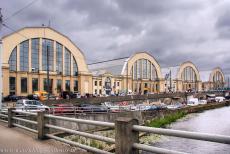
Historic Centre of Riga: The Riga Central Market is housed inside five former German zeppelin hangars. After the First World War, the zeppelin hangars were left behind by the German army at the village of Vaiņode in Latvia, they were transferred to Riga and used as the Riga Central Market. When the Riga Central Market was opened in 1930, it was the largest matket place in Europe. There are only nine zeppelin hangars remaining in the world.
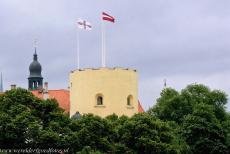
Historic Centre of Riga: The Baroque tower of Riga Castle and the tower of Riga Cathedral. Now, Riga Castle is the residence of the President of Latvia. In the Middle Ages, one of the towers of Riga Castle was part of the fortifications of Riga. The still existing Powder Tower and the Swedish Gate were also part of the fortifications of the historic city of Riga. Riga Castle has six towers, the walls of the castle are about three metres thick.
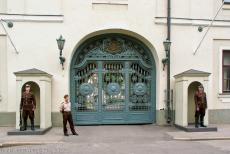
Historic Centre of Riga: Guards at Riga Castle, the official residence of the President of Latvia. Riga Castle was founded in 1330 and reconstructed between the 17th and 19th centuries. Riga Castle became the residence of the Latvian Government in 1938. Riga Castle is also home to a number of museums, the castle is located on the banks of the river Daugava, one of the longest rivers of Latvia. The Historic Centre of Riga was declared a UNESCO World Heritage in 1997.
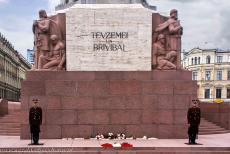
Historic Centre of Riga: The Freedom Monument Milda, the Brīvības Piemineklis. The monument was unveiled in 1935, the Freedom Monument is a national shrine for Latvians in memory of the numerous people who were deported to Siberia during the Soviet occupation and honouring the soldiers who were killed in the Latvian War of Independence between 1918 and 1920. The Freedom Monument is also the symbol of the freedom, independence and sovereignty of Latvia.
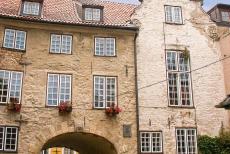
The Swedish Gate in the historic centre of Riga. The gate is part of the old town walls of Riga. The gate was built in 1698 to connect the city with the barracks of the Swedish military garrison outside the town walls of Riga, the gate is a reminder of the period of the Swedish rule over the city. The Swedish Gate leads to one of the narrowest and oldest streets in the historic centre of Riga. The gate is situated in the northern part of the historic centre close to the Riga Cathedral.
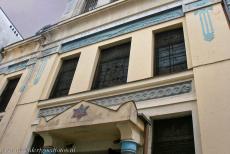
Historic Centre of Riga: The Peitav-Shul is the Jewish Synagogue of Riga, the synagogue was built in the Art Nouveau style in 1903-1905. Under the nazi occupation during the Second World War, all the synagogues of Riga were burned down. The Peitav-Shul is the only synagogue of Riga that has survived. Nowadays, there are only two active synagogues in Latvia, this synagogue in Riga and the synagogue in Daugavpils.
